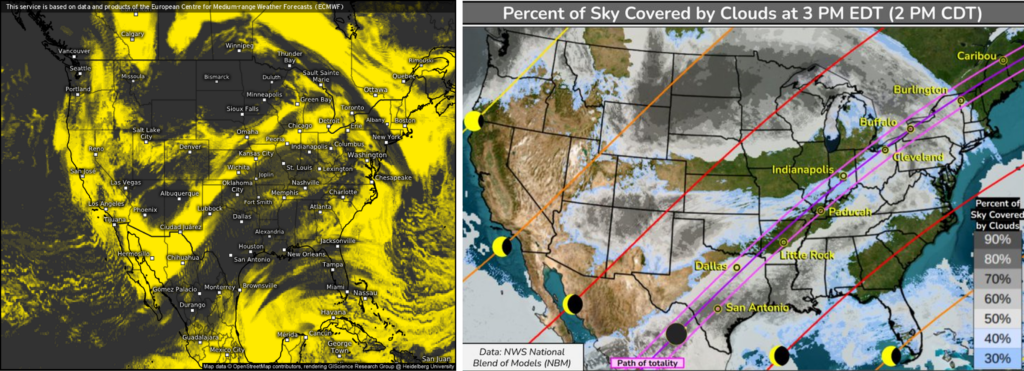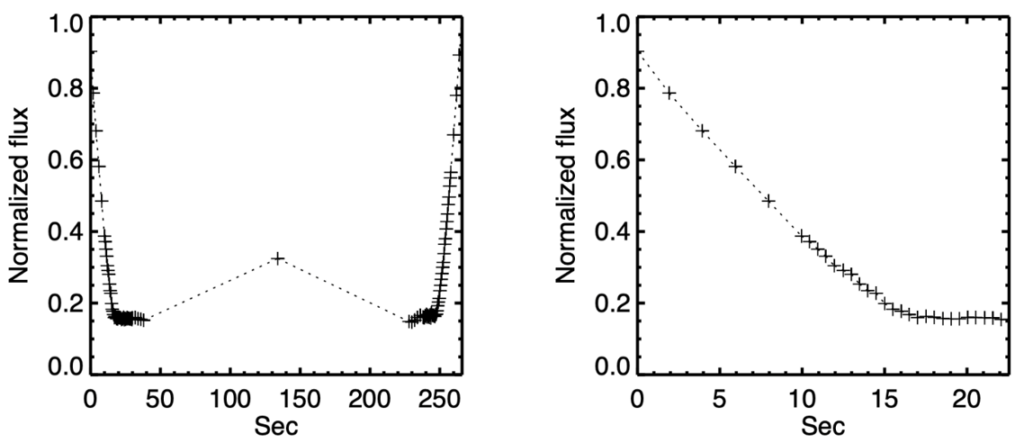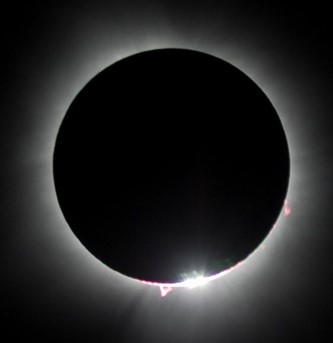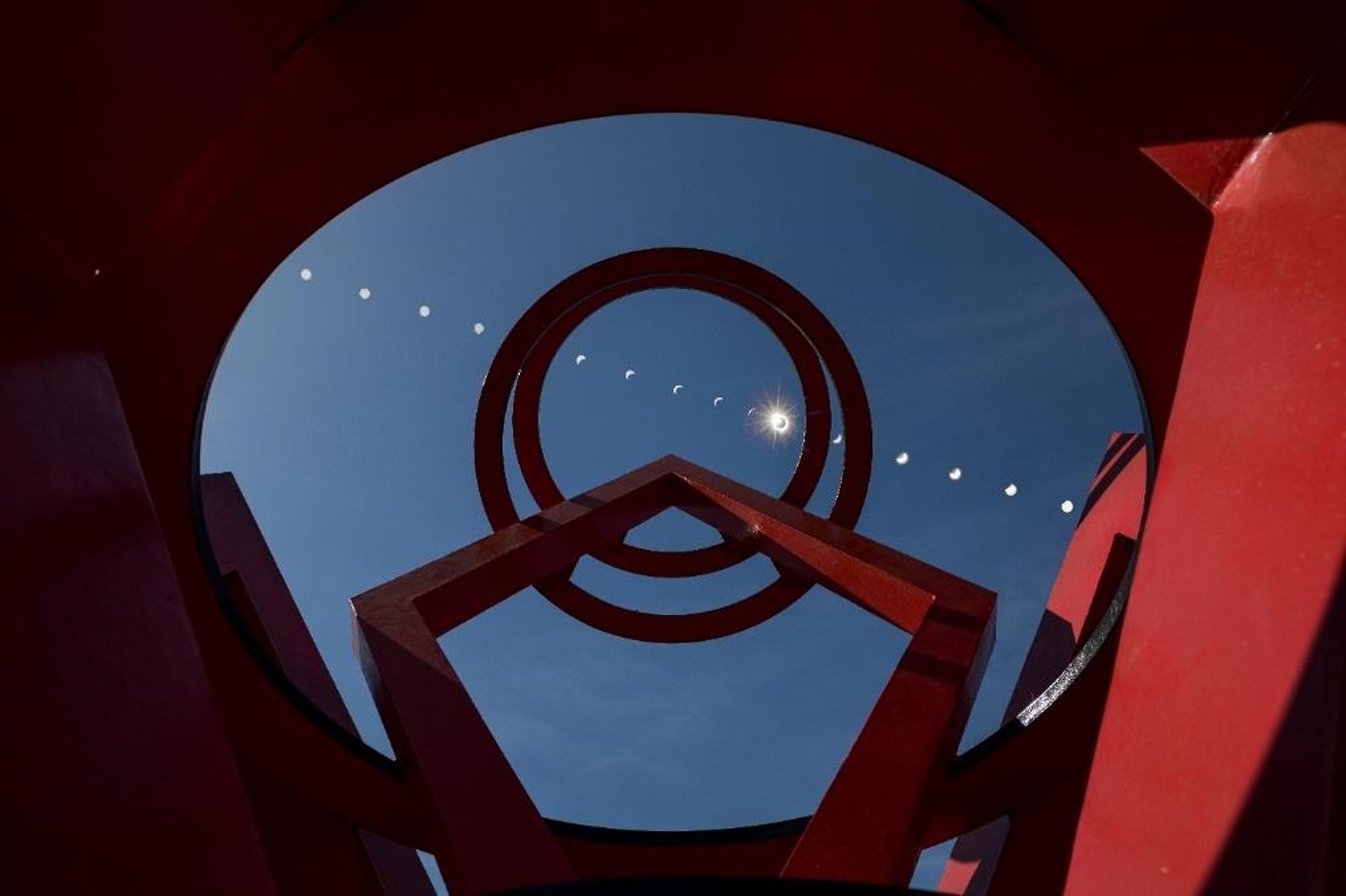Guest post by Gordon Emslie (Western Kentucky University) and Hugh Hudson (University of Glasgow)
During the 2024 North American solar eclipse, a pioneering project aimed to use citizen-science smartphone data to help determine the true shape and size of the sun. How did it turn out? This is part two of a two-part post. Read part one here.
Eclipse-day weather
The SunSketcher program required clear skies, and during the wait for our rapidly approaching, astronomically imposed deadline, the national weather patterns were not looking good. About two days in advance, the predicted region of cloud cover did a remarkable, and indeed seemingly contrived, job of tracing the eclipse path all the way from Mexico to Vermont, with only New Hampshire and Maine mercifully spared.

Despite the gloom, we reportedly had some coverage from about 80% of the users, and we may be able to use much of the data from partially covered sites. (This remains to be assessed as a part of our data analysis.) As often happens during an eclipse, the drastic and sudden cooling of the lower atmosphere, and resulting drop in the ambient lapse rate, resulted in a seemingly magical parting of the clouds for many observers, including one of the authors stationed in Dallas, TX. The other author was at New Harmony, IN, on the banks of the Wabash river between Indiana and Illinois, and was able to witness the entire eclipse without a single cloud in the sky (see featured image at top of post).
Initial analysis of data from the 2024 eclipse
Over 35,000 users downloaded the SunSketcher app and activated it on eclipse day.1 The first user’s data upload from the SunSketcher app proved to be excellent. Here we show the observed variation of the total brightness in each of the 101 images uploaded.

Our task in data analysis is to make detailed measurements of each user’s data in comparison with the LOLA archive prediction, thus allowing progressive adjustment of the assumed solar profile, culminating in a measurement of the height of the solar limb with the highest precision yet achieved. The redundancy of the 35,000 sets of data will let us explore the shape of the Sun and characterize its distortions (such as the oblateness) better than ever before. Contributions from along the path may allow us to search for time variations on time scales of an hour, which would be another first. The great length of the eclipse path will have produced coverage across the track, essential for detecting Baily’s Beads at different azimuthal angles around the Sun/Moon periphery.
1 Because we intentionally did not upload Personally Identifiable Information, we have no idea who these 35,000 citizen scientists were. [We do know, however, that the data presented in Figure 1 was obtained from a phone located in northeastern Ohio.] Nevertheless, they know who they are, and we thank them all for their valuable (and, in all cases, unique) contributions to the SunSketcher project.
Future work
The single “snapshot” of 2024 will have measured the solar oblateness, but we can be sure that effects related to solar magnetism will be evident on time scales of years. Given the success of the SunSketcher app project in 2024, the logical next step is to search for solar-cycle effects on the shape of the solar disk, using succeeding eclipses. For the eclipses of 2026 (the track of which includes Eastern Greenland, Western Iceland, and Northern Spain) and 2027 (Southern Spain, Gibraltar, Algeria, Libya, Egypt, Saudi Arabia and Yemen) we will refine our techniques, for example shifting to “burst mode” photography to improve time resolution around the critical times of second and third contact. We will need to deal with making the app available in different languages, and with legal issues regarding user privacy and international transfer of data. We may also implement a very simple scheme of color selection to help reject contributions from the sun’s reddish chromosphere layer. (Indeed the 2024 eclipse had a very visible pink/red chromospheric prominence, as reported by many observers and as shown below.)

Totality during the 2024 April 8 eclipse, as viewed from New Harmony, IN. Note the conspicuous pink-colored chromospheric prominence at the bottom of the solar disk, near the white-light Baily’s Bead. Credit: Clinton Lewis/WKU.
Closing thoughts
The SunSketcher project is unlike any other science project we have ever conducted. Its blend of technology, functionality, and aesthetics, its absolute dependence on the participation of ordinary people as “citizen scientists,” and the inexorable path toward an absolutely rigid project deadline made for an interesting few months. We are elated that the weather cooperated to an extent far greater than feared in the days leading up to the eclipse, and, given the impossibility of actual “field testing” during other total eclipses, that the app worked as well as it seems to have done.
We have been privileged to be part of an endeavor that introduced tens of thousands of members of the public to participation in solar science. Having taken our collective deep breath, it is time to move on to future eclipses, and the insights into the structure of our nearest star that a lengthy program of SunSketcher observations will ultimately reveal.
You can learn more about SunSketcher at http://sunsketcher.org/.
Featured image: A montage of eclipse stages during the 2024 April 8 eclipse, as viewed through a propitiously erected metal sculpture in New Harmony, IN. This image was also used on the NASA website. Credit: Clinton Lewis/WKU.
